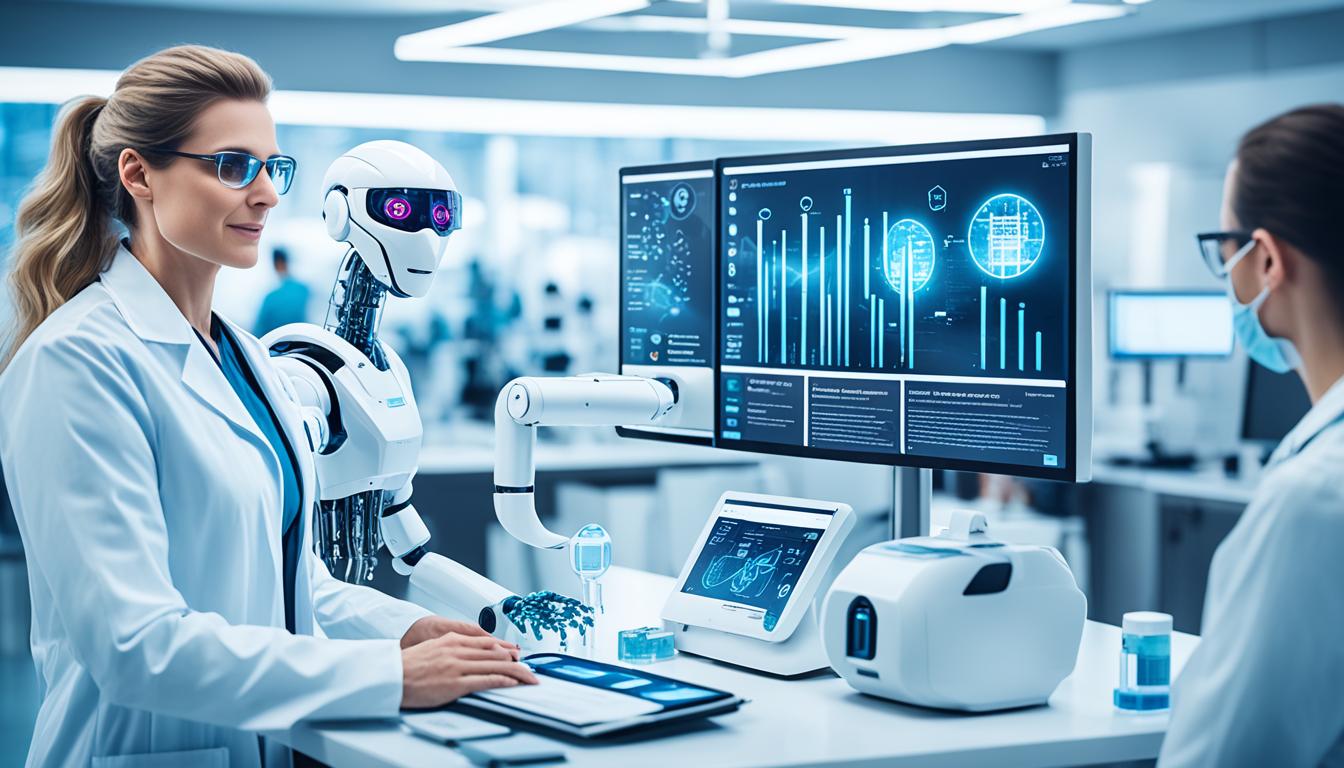The power of machine learning and how advanced algorithms are revolutionizing industries
Machine learning, part of artificial intelligence, is changing many fields. With advanced algorithms, it lets computers learn things like humans. This transforms how companies do their work.
Basically, machine learning uses data and algorithms to create models. These models can predict stuff or act, without direct instructions. It works by making choices, checking its own mistakes, and getting better over time.
Machine learning is shaking up healthcare, finance, manufacturing, and retail. Here’s how it changes these areas:
Key Takeaways:
- Machine learning enables computers to learn from data and make predictions without being explicitly programmed.
- Advanced algorithms underpin the effectiveness of machine learning models.
- Industries such as healthcare, finance, manufacturing, and retail are being revolutionized by machine learning.
- Predictive analytics, data mining, and automation are among the benefits that machine learning brings to these industries.
- Machine learning has the potential to drive innovation and improve efficiency across various sectors of the economy.
What is Machine Learning and How Does It Work?
Machine learning is part of AI, teaching computers without direct instructions. It relies on powerful algorithms to understand big sets of data. This helps computers predict, sort, and make choices using what they’ve learned.
“Machine learning is the science of getting computers to act without being explicitly programmed.” – Jeff Dean, Senior Fellow at Google
But how does machine learning operate? It follows a few critical steps to function:
- Data Collection: It begins with gathering data for the models to study. This data can vary in type, coming from sensors, databases, and the internet.
- Data Preprocessing: Data collected must be cleaned and shaped up for the next phase. This stage ensures the information is ready for analysis.
- Feature Selection: Models zero in on vital data attributes. Choosing these carefully boosts the model’s accuracy and performance.
- Algorithm Training: Next, data meets algorithms to build learning models. Algos tweak themselves to spot and understand patterns better, aiming for fewer errors.
- Model Evaluation: Each model undergoes a test to check its mettle. This step confirms how well it predicts or sorts information.
- Model Deployment: A successful model is put into action in real situations. It helps with forecasting or making choices based on its learning.

Machine learning’s heart lies in its algorithms. They’re crafted to evolve, finding hidden patterns in data for accurate predictions. These statistical methods and models are the brain of machine learning, enabling intelligent decision-making.
This tech is used across many areas, like in health, finance, and advertising. It’s handy for spotting fraud, identifying images, understanding language, and suggesting items.
Benefits of Machine Learning
- Automation: It takes on repetitive jobs, freeing up humans for more strategic work.
- Prediction and Forecasting: It crunches through past data to foresee future trends accurately.
- Personalization: Examining user data leads to tailored suggestions and experiences.
- Improved Decision Making: By diving into big data, it uncovers insights that refine strategies and processes.
It’s the ever-learning aspect that’s shaping new ways of doing business. By getting smarter over time, machine learning aids in better resource use and fosters innovation. Its algorithmic prowess offers a leap forward for those embracing it in the digital realm.
Machine Learning vs. Deep Learning vs. Neural Networks
In AI, machine learning, deep learning, and neural networks are key. They advance tech and change industries.
Neural networks are core to machine learning. They make computers learn from data without being told explicitly how to learn. These algorithms analyze data patterns, offering insights for many areas.
Deep learning is within neural networks, going past usual machine learning. Its algorithms find complex patterns in big data sets. They’re great at learning from data without labels. This lets them see complex relationships and find key data differences.
In contrast to conventional machine learning, deep learning doesn’t need experts to pick out data features. It uses artificial neural networks to find key features in raw data on their own. This makes deep learning strong for computer vision, language processing, and recognizing speech.
Neural networks make up the basis of machine learning and deep learning. They mimic how our brains work, with nodes acting like neurons. By organizing these nodes into layers and tweaking their connections, they process information and make predictions.
So, machine learning is the wider field. Deep learning is a part of neural networks focused on discovering important features. This allows them to solve complex problems more accurately.

Machine learning, deep learning, and neural networks push AI forward. They hold the promise to change industries, create new chances, and fuel innovation for a brighter tomorrow.
Machine Learning Methods: Supervised, Unsupervised, and Semi-Supervised Learning
Machine learning uses advanced algorithms to understand and predict trends. There are three main categories: supervised, unsupervised, and semi-supervised learning.
Supervised Learning
In supervised learning, algorithms get trained with labeled data. This means they have examples to learn from. They use these to make predictions or sorting tasks.
Tasks like detecting spam in emails or spotting fraud in transactions are done by these algorithms. They can also tell what’s in a picture, all thanks to these labeled examples.
Unsupervised Learning
Unsupervised learning is different. Algorithms figure patterns out from unlabeled data. They look for similarities and group data without being told what to look for.
This type helps in grouping markets, finding errors in data, and suggesting items you might like. It helps businesses better target their customers or find unusual activities in their systems.
Semi-Supervised Learning
Semi-supervised learning mixes both types. It uses a bit of labeled data with lots of unlabeled data. This way, it can learn from the few labeled cases and make the most of the rest of the data.
It’s great when you can’t get a lot of examples for your problem. It’s used in speech and text processing. With just a few labeled samples, it can do a lot.

These models, including supervised, unsupervised, and semi-supervised learning, are key in solving tough problems. Knowing how each works helps in many fields, from business to healthcare.
Reinforcement Machine Learning and its Applications
Reinforcement machine learning lets computer programs learn by practicing their skills. They get better by doing, not just by looking at data. It’s special because it teaches computers using a system of rewards. This way of learning is often used in many different areas.
In the world of self-driving cars, reinforcement learning is especially important. These cars use it to get better at making choices. They look at what worked before and use that to decide what to do next. This leads to smarter and safer driving.
Self-driving cars are in very difficult and always changing situations. They have to decide fast. Reinforcement learning helps them get really good at this. It teaches the cars to learn from whatever happens, and that makes them drive better and safer.
Using this method, computers can figure out the best ways to do things. This is great for problems that are too hard for normal computer rules. Problems that need a lot of smart learning, not just following set instructions.
Benefits of Reinforcement Machine Learning in Autonomous Vehicles:
- Improved decision-making in complex and dynamic environments
- Adaptability to changing conditions and unforeseen situations
- Enhanced safety and efficiency on the road
- Potential for reducing accidents and traffic congestion
This learning system makes self-driving cars better at what they do over time. It’s a big step towards cars that really drive themselves well. They get better and better at handling real challenges out there.
As this technology gets even better, it will change how we get around. Reinforcement learning is at the forefront of making self-driving cars the next big thing in transportation.
Figure 1: Illustration of Autonomous Vehicles
Common Machine Learning Algorithms
Machine learning algorithms are key in helping machines learn from data. They then make decisions or predictions. These algorithms power many applications, sparking innovation and solving hard tasks. Let’s look at some well-known machine learning algorithms:

Neural Networks
Neural networks are algorithms imitating the human brain’s neural design. They’re made of connected nodes or neurons. These nodes deal with and transmit information. Neural networks work well in jobs like translating languages naturally, recognizing images, and analyzing feelings. They are great at spotting intricate patterns and ties in data.
Linear Regression
Linear regression is a straightforward, yet powerful, way to predict numbers. It does this by looking at how different variables relate. This method guesses a linear link between the inputs and what they predict. It’s often used in finance, economics, and marketing to guess sales, evaluate prices, and study trends.
Decision Trees
Decision trees are flexible in making value forecasts or sorting data. They use decision rules in a branch-and-node layout. In this setup, each node considers an input to make a decision. Decision trees find use in finance, medicine, and breaking down customers into groups.
Then, there are others like logistic regression, clustering, and random forests. Logistic regression is for classifying into two groups. Clustering groups similar points together. Random forests make lots of decision trees work together to predict better and not overfit.
It’s essential to know these algorithms if you’re into machine learning. Each algorithm works best in its specific situation and data. By using these algorithms, companies and groups can gain deep insights. This helps them make informed, data-driven choices.
Advantages and Disadvantages of Machine Learning Algorithms
Machine learning algorithms are now key in many fields, letting us analyze data well and make smart choices. But, they have upsides and downsides that businesses should think about before using them.
Advantages of Machine Learning Algorithms
- Machine learning excels at spotting patterns in mountains of data. This helps organizations understand their customer needs better and what’s happening in their fields.
- They offer personalized insights and suggestions, making user experiences better and guiding smarter decisions based on context.
- These algorithms automate complex tasks, saving time and resources. This boost in efficiency lets people work on more important things.
- They process huge data sets quickly, letting organizations act fast in critical times. Making fast, accurate decisions can be a game changer.

Figure 7.1: Advantages of Machine Learning Algorithms
Disadvantages of Machine Learning Algorithms
- These algorithms need plenty of varied data to work well, which can be hard to get and costly. So, preparing datasets takes effort.
- If the training data isn’t fair or complete, algorithms might make biased choices. This could lead to unfair treatment.
- Some algorithms can be tough to understand, especially those using deep learning or neural networks. This makes people worry about how they reach decisions.
- There’s also the risk of overfitting, which means the algorithm might do well in tests but fail with new data. This can make its predictions shaky.
“Machine learning algorithms bring big pluses in spotting patterns, giving tailored insights, saving time, and speeding up decision making. But be mindful of challenges like needing good training data, avoiding bias, ensuring transparency, and preventing overfitting to make the most of these tools.”
Conclusion
Machine learning is leading us into the future of AI. It changes how industries work and expands our limits. To keep up in today’s fast-changing world, it’s vital to grasp the might and future of machine learning.
Various types of learning, like supervised or unsupervised, and deep learning are making big differences. They are pushing innovation forward. But we must also keep in mind their limits and think about ethics when using these technologies.
Looking ahead at AI’s role, we must use machine learning wisely. This includes thinking about its effects on society. When we use machine learning while respecting ethical values, it can truly change the game for the better.


